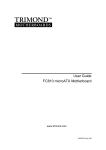Download AOpen i945Ga-PLF Installation guide
Transcript
Table of Contents Table of Contents Table of Contents ................................................................................... 1 1.1 A Thank-you Note Before You Get Start..........................................................4 1.2 Features of This Manual ...............................................................................5 1.3 Safety Information ......................................................................................5 Chapter 2 Introduction to This Motherboard ............................................... 6 2.1 How does your motherboard look like?...........................................................6 2.2 Specification ...............................................................................................7 2.3 Block Diagram ............................................................................................8 Chapter 3 Hardware Installation ............................................................... 9 3.1 Quick Installation Procedure .........................................................................9 3.2 Installation You Have to Know..................................................................... 10 Installing CPU ...........................................................................................10 Installing CPU Cooler .................................................................................11 Installing CPU and System Fans ..................................................................12 Installing Memory Modules .........................................................................13 Maximum The Performance of the Dual Channel............................................14 Connecting IDE and Floppy Cables ..............................................................15 Connecting Front Panel Cable .....................................................................16 Connecting ATX Power Cables .....................................................................17 3.3 Other Installation for Your Reference ........................................................... 18 Setting CPU Voltage and Frequency .............................................................18 Connecting Serial ATA II ............................................................................19 Adjusting your Hard Disk Setting.................................................................20 Connecting PCI Express x 16 Graphics Slot...................................................22 Connecting PCI Express x 1 Slot..................................................................23 Connecting IrDA........................................................................................24 Connecting Game Port ...............................................................................25 1 Gigabit LAN Supported...............................................................................26 Connecting USB2.0....................................................................................27 Connecting 1394 .......................................................................................28 Super 7.1 Channel Audio Effect ...................................................................29 Connecting Front Audio ..............................................................................30 Connecting CD_IN .....................................................................................31 Connecting COM2 ( for i945Ga-PLF only)......................................................32 Connecting Case Open ...............................................................................33 Connecting S/PDIF (Sony/Philips Digital Interface) ........................................34 Colored Coded Back Panel (for i945Ga-PLF) ..................................................35 Colored Coded Back Panel (for i945Pa-PLF) ..................................................36 LED Indication ..........................................................................................37 3.4 Jumper Settings ........................................................................................ 38 Chapter 4 Special Features and Utilities................................................... 39 4.1 Other Useful Features ................................................................................ 39 Chapter 5 Setting BIOS......................................................................... 40 5.1 Introduction ............................................................................................. 40 5.2 How To Use Phoenix-Award™ BIOS Setup Program ........................................ 41 5.3 How To Enter BIOS Setup ........................................................................... 41 5.4 Definition of Power Master .......................................................................... 42 Automatic Mode ........................................................................................43 Performance Mode.....................................................................................43 Silent Mode ..............................................................................................44 Normal Mode ............................................................................................44 5.5 BIOS Upgrade under Windows environment.................................................. 45 5.6 Vivid BIOS technology ............................................................................... 47 Chapter 6 Installing Drivers ................................................................... 48 6.1 Installing Drivers....................................................................................... 49 6.2 Installing Utilities ...................................................................................... 50 2 Chapter 7 Troubleshooting..................................................................... 51 Chapter 8 Technical Support .................................................................. 52 Model Name and BIOS Version....................................................................53 Register Your Motherboard .........................................................................53 Technical Support......................................................................................54 3 1.1 A Thank-you Note Before You Get Start First of all, we would like to express our gratitude for purchasing AOpen products. Once again, this motherboard is designed uniquely to meet all your personal needs with our great industry-designing ability and our everlasting perseverance to the quality of all our products. This manual will introduce you how this motherboard is installed. Please keep it well for your future reference. If you lost your printed manual, you may also go to our website at http://www.aopen.com to download the updated file. Now, we would like to invite you to personally experience this user-friendly manual and all of the powerful functions this AOpen product offers. The logos of Adobe and Acrobat are the registered trademarks of Adobe Systems Incorporated. The logos of AMD, Athlon, and Duron are the registered trademarks of Advanced Micro Devices, Inc. The logos of Intel, Intel Celeron, Pentium II, III, Pentium 4 and Pentium M are the registered trademarks of Intel Corporation. The logos of nVidia are the registered trademarks of nVidia Corporation. The logos of Microsoft, Windows are the registered trademarks of Microsoft Corporation in America and other countries. All the titles of the products and the trademarks mentioned in this manual are for the purpose of illustrative conveniences and are possessed by their respective firms. We regret not informing about any changes in usage standards and other related information. AOpen reserves the right of altering or modifying the content of this manual. In case of any mistakes or incorrect descriptions, which include those on the products, AOpen makes no guarantee or commitments. This document is based on the copyright laws in order to protect our company and reserve all rights. Under no circumstances are any types of duplicating and loading this brochure in any databases and media permitted except the permission signed on formal document by AOpen Company. 1996-2005 Copyrights, AOpen Ltd. All rights reserved. 4 1.2 Features of This Manual To help you grab the useful information of this motherboard and aware of certain conditions that you might need to know, you will see the icons below frequently: Note This contains knowledge you should know in process of assembling, or some helpful tips. Warning / Caution Warning Please be careful when you see this mark. It highlights mistakes that occur often during assembling, or something you need to pay attention to. Tip Warning This tip tells you some useful information that will make your installation smoothly. 1.3 Safety Information Please wear a wrist strap and attach it to a metal part of the system unit before handling a component. Alternatively, you can also touch an object that is of ground connection or with metal surface. Always unplug the power before you make any jumper setting. Before you install or remove any components on the motherboard, please make sure to disconnect the power first in case of damaging motherboard or other components. 5 Chapter 2 Introduction to This Motherboard Chapter 2 Introduction to This Motherboard 2.1 How does your motherboard look like? 17 1 18 19 2 20 3 21 4 22 5 23 6 7 24 25 8 26 9 27 10 28 11 29 12 30 13 31 14 32 15 33 1. COM2 Connector (i945Ga-PLF only) 16 18. Realtek AC’97 CODEC 2. JP28 PS2 KB/Mouse Wakeup Jumper 19. Front Audio Connector 3. 4-pin 12V ATX Power Connector 20. S/PDIF Connector 4. SYSFAN1 Connector 21. Realtek Gigabit LAN Chip 5. PCI Express x1 Slots X 2 22. Game port 6. PCI Express x16 Graphics slot 23. 32-bit PCI Expansion Slots x 3 7. LGA775 CPU Socket supporting Intel FC-LGA4 . CPU 24. IrDA connector 8. STBY LED 25. IEEE 1394 Connector X 1 9. Intel 945G / ICH7 (i945Ga-PLF) Intel 945P / ICH7 (i945Pa-PLF) 26. FDD connector 10. 240-pin DDR II DIMMs x 4 27. Serial ATA II connector x 4 11. CPU FAN connector 28. USB 2.0 Connectors x 2 12. BOOT LED 29. Case Open Connector 13. ATX Power Connector 30. JP14 CMOS Data Clear Jumper 14. PWRFAN Connector 31. Front Panel Connector 15. Power Temperature Connector 32. ATA133 Connector 16. ATA100 Connector 33. SYSFAN2 Connector 17. CD_IN Connector 6 2.2 Specification Here is the main function of your motherboard. Models CPU Chipset Main Memory Graphics IDE LAN Sound USB IEEE 1394 Slots Back Panel I/O On Board Connector BIOS Board Size i945Ga-PLF Intel FC-LGA4 CPU Socket T 533/800/1066MHz Intel 945G/ICH7 Dual Channel Mode DDRII DDRII 400/533/667 DDR DIMM x 4 DIMM Type : 128/256/512MB & 1GB Max Memory : 4GB Integrated VGA Engine in chipset PCI Express x 16 Graphics slot Support ADD2 card Integrated ATA100 and Serial ATA II Controller ITE External IDE ATA133 control chip Max Disk: 144,000,000GB [by 48 bits LBA Spec.] Realtek Gigabit PCI LAN Chip Intel High Definition Audio on-Board Support 7.1 Channel and above Integrated in chipset, USB 2.0 x 8 Agere 1394 Control Chip PCI Express x 1 slots x 2 PCI Express x 16 graphics slot x 1 PCI slots x 3 PS/2 Keyboard x 1, PS/2 Mouse x 1 USB Port x 4, LAN Port x 1 VGA Port x 1, COM Port x 1 Printer Port x 1, IEEE 1394 x 1 Speaker_Out x 1, Line_In x 1, MIC_In x 1 Side SUR x 1, Rear SUR x 1 Center/Subwoofer x 1 Floppy Drive Connector x 1 IDE Channel: ATA100 x 1 IDE Channel: ATA133 x 2 Serial ATA II Channel x 4 Front Panel x 1 Front Audio x 1 CPU FAN x 1 System FAN x 2, Power FAN x 1 Power Temperature Connector x 1 Case Open Connector x 1 CD_IN x 1, IrDA x 1, S/PDIF x 1 COM2 x 1 Game Connector x 1 IEEE 1394 x 2 USB2.0 Connectors x 2 Award PnP 4Mb Flash ROM BIOS 305 mm x 230 mm 7 i945Pa-PLF Intel FC-LGA4 CPU Socket T 533/800/1066MHz Intel 945P/ICH7 Dual Channel Mode DDRII DDRII 400/533/667 DDR DIMM x 4 DIMM Type : 128/256/512MB & 1GB Max Memory : 4GB PCI Express x 16 Graphics slot Integrated ATA100 and Serial ATA II Controller ITE External IDE ATA133 control chip Max Disk: 144,000,000GB [by 48 bits LBA Spec.] Realtek Gigabit PCI LAN Chip Intel High Definition Audio on-Board Support 7.1 Channel and above Integrated in chipset, USB 2.0 x 8 Agere 1394 Control Chip PCI Express x 1 slots x 2 PCI Express x 16 graphics slot x 1 PCI slots x 3 PS/2 Keyboard x 1, PS/2 Mouse x 1 USB Port x 4, LAN Port x 1 COM Port x 2 Printer Port x 1, IEEE 1394 x 1 Speaker_Out x 1, Line_In x 1, MIC_In x 1 Side SUR x 1, Rear SUR x 1 Center/Subwoofer x 1 Floppy Drive Connector x 1 IDE Channel: ATA100 x 1 IDE Channel: ATA133 x 2 Serial ATA II Channel x 4 Front Panel x 1 Front Audio x 1 CPU FAN x 1 System FAN x 2, Power FAN x 1, Power Temperature Connector x 1 Case Open Connector x 1 CD_IN x 1, IrDA x 1, S/PDIF x 1 Game Connector x 1 IEEE 1394 x 2 USB2.0 connectors x 2 Award PnP 4Mb Flash ROM BIOS 305 mm x 230 mm 2.3 Block Diagram ATA 66/100/133 LGA775 Socket Intel FC-LGA4 CPU VGA Onboard (i945Ga-PLF) 300MB/s Serial ATA II Ports x 4 PCI Bus 32-bit PCI Slots x3 533/800/1066 MHz System Bus 500MB/s PCI Express x 1 Slots x 2 PCI Express x16 Intel 945G / 945P Chipset Graphics Slot Support ADD2 Card AC’97 CODEC (for i945Ga-PLF) DDRII DIMM x 4 IDE Drives x 6 Dual Channel DDRII 400/533/667 SDRAM Up to 4GB Realtek Gigabit LAN Chip ICH7 LAN connect Component 4Mbits Flash EEPROM Agere IEEE 1394 Controller Parallel Port Floppy Disk Drive Winbond Super I/O IEEE 1394 x 2 Serial Ports x 2 8 USB 2.0 x 8 Chapter 3 Hardware Installation Chapter 3 Hardware Installation 3.1 Quick Installation Procedure 12. Installing Drivers & Utilities 1. Installing CPU 11. Installing Operating System (such as, Windows XP) 2. Installing CPU Fan & System Fan 3. Installing Memory Module 10. Loading Default BIOS, Setting CPU Frequency 4. Installing HD, CD-ROM and SATA Disk, etc 9. Connecting Back Panel Ports (Keyboard, Mouse, etc) 8. Installing Other Devices (USB, Front Audio, etc) 5. Connecting Front Panel Cable 7. Installing PCI Express x16 Graphics cards & PCI Express x 1 cards & PCI Cards 6. Connecting ATX Power Cable 9 3.2 Installation You Have to Know Installing CPU This socket supports FC-LGA4 CPU, which is the latest CPU package developed by Intel. Other forms of CPU package are impossible to be fitted in. 1. Pull CPU socket lever and plate up. 2. Remove plastic cap from CPU socket plate. 3. Locate Pin 1 in the socket and look for a golden arrow on the CPU upper interface. Match Pin 1 and golden arrow. Then insert the CPU into the socket. 4. Press down the CPU socket plate and lever to finish CPU installation. CPU socket plate Plastic cap Plastic cap CPU socket lever Socket Pin 1 Warning: If you do not match the CPU socket Pin 1 and CPU golden arrow well, you may damage the CPU. And please don’t touch CPU socket pins when installing CPU. Note: It’s strongly recommended by Intel to use thermal paste properly to avoid over-heat generated from Prescott CPU. 10 Golden arrow Installing CPU Cooler 1. Gently put down the CPU fan on CPU socket with four sticks aiming correctly to the four mounting holes. Mounting Mounting hole hole 2. Press down four fixing sticks into the holes one by one. Make sure the sticks are firmly fixed into the holes. Fixing stick Note: The picture above may look different from the product you purchased. 11 Installing CPU and System Fans Plug the CPU fan cable to the 4-pin CPUFAN connector. If you have chassis fan, you can also plug it in SYSFAN1 or SYSFAN2 connector. GND +12V Sensor SYSFAN1 Connector PWM SENSOR +12V GND GND +12V Sensor CPUFAN Connector SYSFAN2 Connector Note: Some CPU fans do not have sensor pin so that they cannot support fan monitoring. 12 Installing Memory Modules DIMM slots are designed in black and navy blue which are very easy to recognize. Insert the module straight down to the DIMM slot with both hands and press down firmly until the DIMM module is securely in place. Tab Pin 1 Key Note: The tabs of the DIMM slot will clip to hold the DIMM in place when the DIMM touches the slot’s bottom. 13 Maximum The Performance of the Dual Channel To obtain the highest performance of Dual Channel, the configuration of DIMM must meet the following conditions. Matched DIMM configuration in each channel ● Same density (128MB~1GB) As long as you insert memory modules of same density into Channel 1 (DIMM1 & DIMM3) and Channel 2 (DIMM2 & DIMM4), dual channel mode will be enabled. DIMM1 + DIMM3 = DIMM2 + DIMM4 Ex: if you insert 1GB memory module into DIMM1 and DIMM3, dual channel mode will be enabled when DIMM2 + DIMM4 = 1GB ● Same DRAM bus width (x8 or x16) ● Either single-sided or double-sided Note: Using memory modules of different chip will cause system unstable. When dual channel mode is successfully enabled, the screen will show “Dual Channel Mode Enabled” while entering POST screens. 14 Connecting IDE and Floppy Cables Connect the 34-pin floppy cable and 40-pin, 80-wire IDE cable to floppy connector and IDE connector. Be careful of the pin1 orientation. Wrong orientation may cause system damage. Pin 1 Pin 1 FDD Connector Primary Slave (2nd) Primary Master (1st) ATA 33/66/100 IDE Connector Secondary Secondary Slave (4th) Master (3rd) IDE 3 (Secondary) Pin 1 IDE 2 (Primary) Primary Primary Slave (2nd) Master (1st) ATA 66/100/133 IDE Connector (iTE IT8211F) 15 Connecting Front Panel Cable Attach the power LED, speaker and reset switch connectors to the corresponding pins. If you enable “Suspend Mode” item in BIOS Setup, the ACPI & Power LED will keep flashing while the system is in suspend mode. Locate the power switch cable from your housing, which is a 2-pin female connector from the housing front panel. Plug this connector to the soft-power switch connector marked SPWR. 1 NC NC +5V HDD LED HDD LED +5V +5V GND NC SPEAKER Power Switch GND Power LEDGND Power LED+ NC GND GND RESET GND Front Panel Connector 16 Connecting ATX Power Cables This motherboard comes with a 24-pin and 4-pin ATX power connector as shown below. Make sure you plug them in the right direction. We strongly recommend you to insert the 4-pin connector before connecting the 24-pin connector. +12V +12V Ground Ground Note: Please aim the power plug at the left side of the 24-pin ATX power connector when the foolproof design faces you as shown. Aiming at the left side Foolproof 17 3.3 Other Installation for Your Reference Setting CPU Voltage and Frequency Setting CPU Core Voltage This motherboard supports Voltage ID (VID) function to detect CPU voltage automatically during power-on. It’s not necessary to set CPU core voltage. Setting CPU Frequency This motherboard is CPU jumper-less design; you can set CPU frequency by 1MHz stepping CPU Overclocking in the BIOS. CPU Core Frequency = CPU FSB clock x CPU Ratio. However, all CPU now sold in market belong to "Fixed Multiplier". That means users can not adjust the CPU Ratio but change CPU FSB clock to achieve overclocking only. BIOS Setup > Frequency / Voltage Control > CPU Speed Setup (Users will do the overclocking at their own risk!!) CPU Ratio 8x, 10x… 24x, 25x, 26x, 27x, 28x CPU FSB FSB = 100MHz-250MHz by 1MHz Stepping CPU Overclocking (Adjustment manually) Processor Processor Number Frequency Extreme Edition Processor 3.73G 8 Series 840 3.20G 830 3.00G 820 2.80G 6 Series 670 3.80G 660 3.60G 650 3.40G 640 3.20G 630 3.00G 5 Series 570 560 550 540 530 520 3 Series 355 350 345 340 335 330 FSB CPU Ratio Cache 1066MHz 14x 2MB L2 800MHz 800MHz 800MHz 16x 15x 14x 2 x 1MB L2 2 x 1MB L2 2 x 1MB L2 800MHz 800MHz 800MHz 800MHz 800MHz 19x 18x 17x 16x 15x 2MB 2MB 2MB 2MB 2MB L2 L2 L2 L2 L2 3.80G 3.60G 3.40G 3.20G 3.00G 2.80G 800MHz 800MHz 800MHz 800MHz 800MHz 800MHz 19x 18x 17x 16x 15x 14x 1MB 1MB 1MB 1MB 1MB 1MB L2 L2 L2 L2 L2 L2 3.33G 3.20G 3.06G 2.93G 2.80G 2.66G 533MHz 533MHz 533MHz 533MHz 533MHz 533MHz 25x 24x 23x 22x 21x 20x 256K 256K 256K 256K 256K 256K L2 L2 L2 L2 L2 L2 Note: With CPU speed changing rapidly, there might be faster CPU on the market by the time you received this installation guide. This table is kindly for your references only. 18 Warning: Intel 945G / 945P chipset support maximum 1066MHz (266MHz*4) system; higher clock setting may cause serious system damage. Note: Some CPU fans do not have sensor pin so that they can’t support fan monitoring. Connecting Serial ATA II To connect a serial ATA II disk, you have to have a 7-pin serial ATA cable. Connect two ends of the serial ATA II cable to the serial ATA II header on the motherboard and the disk. Like every other traditional disk, you also have to connect a power cable. Please be noted that it is a jumper free implement; you don’t need to set jumpers to define a master or slave disk. When serial ATA II hard disks are installed on serial ATA II ports, the one connected on Port0 (SATA1) will be set as the first boot device automatically. Please note that it doesn’t support Hot-Plug in function. SATA 2.0 Port1 SATA 2.0 Port2 SATA 2.0 SATA 2.0 Port3 Port4 19 Adjusting your Hard Disk Setting Except its original 1 set of parallel IDE, this motherboard supports the latest serial ATA hard disk. If you are unable to find your newly installed serial ATA hard disks on your operating system after having them installed, the problem may lie in the BIOS setting. You can simply adjust BIOS settings to have them work properly. After installing your hard disks properly, you can directly go to BIOS setting screen for adjustment. Simply pressing “Integrated Peripherals Æ OnChip IDE Device Æ On-Chip Serial ATA” to choose your preferable mode. If you have no intention of changing its original setting, the default would be Auto. 20 If you desire to change the default setting, press Enter for selection list: Disabled: You can choose this item if there are only traditional IDE hard disks had been installed on your system. Disabling this item will also cancel the detection of serial ATA hard disks during POST, which will theoretically speed up your boot-up time a little bit; however, please remember to re-adjust the setting here if you want to use serial ATA hard disk later. Auto: This is factory default setting on this motherboard. Basically, if your system functions properly, it is no necessary to change it. The system will automatically recognize PATA (IDE) as primary.. Combined Mode: If you have traditional IDE hard disks and serial ATA hard disks installed at the same time, then you can choose this mode. Under this mode, you can randomly choose either IDE hard disks or serial ATA had disk as your first boot device. But please note, IDE will exist with serial ATA in a mapping way, which means it will occupy one of the serial Channel and leave you one serial Channel only. When PATA Mode is set to primary, SATA3 and SATA4 will be set to secondary, and when PATA Mode is set to secondary, SATA1 and SATA2 will be set to primary. Enhanced Mode: If you are using the latest operating system (say, Windows XP, Windows.NET Server), it is highly recommended that you select Enhanced Mode. Under this mode the system will detect all six devices (traditional IDE x 2, Serial ATA x 4) completely and function perfectly. But please note that PATA Mode is set to primary under this mode. Note: According to practical lab tests of us, there are no obvious problems or mistakes happened when we set this mode under Windows2000 operating system; however, it is not recommended by Intel. SATA Only: You may select this mode if you install serial ATA hard disks only. 21 Connecting PCI Express x 16 Graphics Slot i945Ga-PLF / i945Pa-PLF provides a PCI Express x 16 Graphics slot, a red slot having the latest PCI Express x 16 specification on motherboard. The PCI Express x 16 is a bus interface targeted for high-performance 3D graphic. Traditionally AGP used both rising and falling edge of the 66MHz clock for 8X AGP, and the data transfer rate could achieve 2.1GB/s. Now PCI Express x 16 is moving to higher data transfer rate, which is upgraded to 8.0GB/s (250MB/s x 16 x 2, it’s 4.0GB/s per direction). For i945Ga-PLF, the PCI Express x16 Graphics slot can automatically recognize a PCI Express x 16 Graphics or a Multiplexed Intel DVO Output depending on which cards being inserted, such as PCI Express x 16 Graphics, or ADD2 (AGP Digital Display 2) cards. With an ADD2 card implemented to this slot, Multiplexed Intel DVO output will provide high-speed digital connection for digital displays or TV-OUT functionality. 22 Connecting PCI Express x 1 Slot This motherboard provides two PCI Express x 1 slots, which are located between the PCI Express x 16 and traditional PCI slot. In order to go with the step of today’s and tomorrow’s processors, PCI Express x 1 provides higher I/O bandwidth. The transfer data rate could achieve 250MB/s, which is close to twice the traditional PCI 2.2 data transfer rate. You could install any PCI Express x 1 device in the slot for your preference. 23 Connecting IrDA The IrDA connector can be configured to support wireless infrared module, with this module and application software such as Laplink or Windows Direct Cable Connection, user can transfer files to or from laptops, notebooks, PDA devices and printers. This connector supports both HPSIR (115.2Kbps, 2 meters) and ASK-IR (56Kbps). Install an infrared module onto the IrDA connector and enable the infrared function from BIOS Setup, UART Mode, you can use this function. Please make sure you connect correct orientation when plugging IrDA module. Pin 1 1 NC +5V IR_TX KEY GND IR_RX IrDA Connector 24 Connecting Game Port This motherboard comes with a game port (Joystick-Midi) for you to connect any midi devices or joysticks. To use this function you have to have a joystick module and connect it with a game port cable to this port on the motherboard. Pin1 1 2 +5V JBB1 +5V JAB1 JACX GND GND JACY JAB2 JBCX MIDI_TXD JBCY JBB2 MIDI_RXD KEY +5V 15 16 Game Port Connector (User Upgrade Optional) 25 Gigabit LAN Supported On the strength of Realtek Gigabit LAN controller on board, this motherboard provides 10/100/1000Mbps Ethernet for office and home use. The Ethernet RJ45 connector is located on the top of USB connectors. The right hand side LED indicates link mode; it lights in yellow when linking to network. The left hand side LED indicates the transfer mode and will light in green when data is transferring at 100Mbps (never lights while at 10Mbps), but will light in orange when transferring in Gigabit’s mode. To enable or disable this function, you may simply adjust it through BIOS. To enable LAN wakeup function, you have to set the “Wake on PCI Card” enable in the BIOS “Power Management Setup” section. Speed LED (Left) Green 100Mbps Orange Gigabit mode ACT LED (Right) Yellow 26 Connecting USB2.0 This motherboard provides eight USB 2.0 ports to connect USB devices such as mouse, keyboard, modem, printer, etc. There are four ports on the back panel. You can use proper cables to connect Front USB connector to USB modules or chassis front panel. Pin 1 Pin 1 1 2 +5V SBD7SBD7+ GND +5V SBD6SBD6+ GND KEY NC 9 10 USB Connector 27 Connecting 1394 With IEEE1394 Chip on board (Agere 1394), having its data transfer rate up to 400Mb/s, this interface can connect to devices that require high data transferring performance such as digital camera, scanner or others IEEE 1394 devices. Please use appropriate cables to connect IEEE1394 devices. Pin1 1 2 TPA+ GND TPB+ +12V (Fused) TPAGND TPB+12V (Fused) SHIED GND IEEE 1394 Connector Warning: Please note that Hot-Plug is not allowed on IEEE 1394 headers; doing so will burn the controller IC and damage the motherboard. 28 Super 7.1 Channel Audio Effect This motherboard comes with an AC’97 (Realtek ALC880) CODEC, which supports the latest 7.1 Channel with high quality of audio effects, bringing you a brand new audio experience. This motherboard provides 7.1 Channel ports shown as below. Picture represents the standard location of all speakers in 7.1 Channel sound tracks. Please connect the plug of your front speakers to the green “Speaker out” port , rear surround speakers to orange port, side surround speakers to gray port and both of the center and subwoofer speakers to black port on the back panel. 29 Connecting Front Audio If the housing is designed with an audio port on the front panel, you’ll be able to connect onboard audio to front panel through this connector. By the way, please remove the jumper cap from the Front Audio Connector before you connect the cable. Do not remove this yellow jumper cap if your housing doesn’t have an audio port on the front panel. Pin1 1 AUD_MIC AUD MIC BIAS AUD_FPOUT_R NC AUD_FPOUT_L AUD_GND AUD_VCC AUD_RET_R KEY AUD_RET_L Front Audio Connector 30 Connecting CD_IN This connector is designed to connect CD Audio cable from CDROM or DVD drive to onboard sound. R GND L AUX-IN Connector 31 Connecting COM2 ( for i945Ga-PLF only) i945Ga-PLF provides two serial ports. One of them is on back panel connector, and the other is on the upper of CPU socket. With proper cable, you can connect it to the back panel of chassis. Pin 1 GND SOUT DCD# RTS RI# 1 2 CTS# DSR# Sin DTR# COM Connector 32 Connecting Case Open The “CASE OPEN” header provides chassis intrusion-monitoring function. To make this function work, you have to enable it in the system BIOS, connect this header to a sensor somewhere on the chassis. So, whenever the sensor is triggered by lights or by the opening of the chassis, the system will beep to inform you. Please be informed that this useful function only applies to advanced chassis; you may purchase an extra sensor, attach it on your chassis and make a good use of this function. Pin 1 1 GND Sensor Chassis Intrusion Connector 33 Connecting S/PDIF (Sony/Philips Digital Interface) S/PDIF (Sony/Philips Digital Interface) is a newest audio transfer file format, which provides impressive audio quality through optical fiber and allows you to enjoy digital audio instead of analog audio. Through a specific audio cable, you can connect the S/PDIF connector to other end of the S/PDIF audio module, which bears S/PDIF digital output. Normally there are two S/PDIF outputs as shown, one for RCA connector, the most common one used for consumer audio products, and the other for optical connector with better audio quality. Same as outputs, you can also connect RCA or optical audio products to input connectors on the module and have the voice or music come out from your computer. However, you must have a S/PDIF supported speaker/amplifier/decoder with S/PDIF digital input/output to connect to the S/PDIF digital input/output to make the most out of this function. Pin 1 1 +5V KEY SPDIF OUT GND SPDIF IN 5 S/PDIF Connector (RCA) S/PDIF OUT S/PDIF IN S/PDIF Cable S/PDIF OUT S/PDIF IN (Optical) S/PDIF Module (User Upgrade Optional) 34 Colored Coded Back Panel (for i945Ga-PLF) The onboard I/O devices have PS/2 Keyboard, PS/2 Mouse, RJ-45 LAN Connector, COM1, VGA port, USB, IEEE 1394, AC’97 sound and Parallel ports. The view angle of drawing shown here is from the back panel of the housing. PS/2 Mouse Connector SPP/EPP/ECP Parallel Port IEEE 1394 RJ45 LAN Jack Rear SUR Line-In Speaker Out Center/ Subwoofer MIC-In PS/2 Keyboard COM1 Port Connector VGA Port USB 2.0 Ports Side SUR PS/2 Keyboard: For standard keyboard, which use a PS/2 plug. PS/2 Mouse: For PC-Mouse, which use a PS/2 plug. Parallel Port: To connect with SPP/ECP/EPP printer. COM1 Port: To connect with pointing devices, modem or others serial devices. RJ-45 LAN Port: To connect Ethernet for home or office use. VGA Connector: To connect with PC monitor. USB Port: Available for connecting USB devices. IEEE 1394 Port: Available for connecting IEEE 1394 interface devices. Side SUR: For side surround speaker. Center/Subwoofer: For center & subwoofer speaker. Rear SUR: For rear speaker. Speaker Out: To External Speaker, Earphone or Amplifier. Line-In: Comes from the signal sources, such as CD/Tape player. MIC-In: For Microphone 35 Colored Coded Back Panel (for i945Pa-PLF) The onboard I/O devices have PS/2 Keyboard, PS/2 Mouse, RJ-45 LAN Connector, COM1, COM2, USB, IEEE 1394, AC’97 sound and Parallel ports. The view angle of drawing shown here is from the back panel of the housing. PS/2 Mouse Connector SPP/EPP/ECP Parallel Port IEEE 1394 RJ45 LAN Jack Rear SUR Line-In Speaker Out Center/ Subwoofer MIC-In PS/2 Keyboard COM1 Port Connector COM2 Port USB 2.0 Ports Side SUR PS/2 Keyboard: For standard keyboard, which use a PS/2 plug. PS/2 Mouse: For PC-Mouse, which use a PS/2 plug. Parallel Port: To connect with SPP/ECP/EPP printer. COM1 / COM2 Port: To connect with pointing devices, modem or others serial devices. RJ-45 LAN Port: To connect Ethernet for home or office use. USB Port: Available for connecting USB devices. IEEE 1394 Port: Available for connecting IEEE 1394 interface devices. Side SUR: For side surround speaker. Center/Subwoofer: For center & subwoofer speaker. Rear SUR: For rear speaker. Speaker Out: To External Speaker, Earphone or Amplifier. Line-In: Comes from the signal sources, such as CD/Tape player. MIC-In: For Microphone 36 LED Indication LED indication including Standby LED and BOOT LED are AOpen’s considerate designs that aim at providing you friendly system information. STBY LED will light up when power is provided to the motherboard, giving you a convenient indication check the system power status in circumstances such as power on/off, stand-by mode and RAM power status during Suspend to RAM mode. BOOT LED will keep blinking when you power the system on and when your system is under POST (Power-On Self Test). After POST diagnoses everything all right and finishes the booting, the LED will stay on otherwise it will remain flashing to warn you that mistakes have occurred during POST. v STBY LED BOOT LED 37 3.4 Jumper Settings JP28 Keyboard / Mouse Wakeup Jumper This motherboard provides PS2 keyboard / mouse wake-up function. 1 1 Disable (Default) Enable JP28 PS2 KB/Mouse Wakeup Jumper 1 Normal (Default) 1 Clear CMOS JP14 Clear CMOS Jumper You can clear CMOS to restore system default setting. To clear the CMOS, follow the procedure below. JP14 Clear CMOS Data 1. Turn off the system and unplug the AC power. 2. Remove ATX power cable from connector PWR3. 3. Locate JP14 and short pins 2-3 for a few seconds. 4. Return JP14 to its normal setting by shorting pin 1 & pin 2. 5. Connect ATX power cable back to connector PWR3. 38 Chapter 4 Special Features and Utilities Chapter 4 Special Features and Utilities 4.1 Other Useful Features With excellent design ability of R&D team, AOpen boasts for its various powerful and handy features that come with our product like follows. You are welcomed to visit our technical website to learn more about those features. http://english.aopen.com.tw/tech/techinside 39 Chapter 5 Setting BIOS Chapter 5 Setting BIOS 5.1 Introduction System parameters can be modified by going into BIOS Setup menu; this menu allows you to configure the system parameters and save the configuration into the 128 bytes CMOS area (normally in the RTC chip or in the main chipset). The Phoenix-Award BIOS™ that installed in the Flash ROM of the motherboard is a custom version of an industry standard BIOS. The BIOS provides critical low-level support for standard devices such as hard disk drives, serial and parallel ports. AOpen’s R&D engineering team had optimized most BIOS settings of this motherboard. However, some default settings of BIOS cannot fine-tune those sections that controlled by chipset. Therefore, this chapter is intended to guide you and help you to configure some other settings. To enter BIOS setup menu, press <Del> when POST (Power-On Self Test) screen is shown on your monitor. Note: Because BIOS code is the most often changed part on motherboard, the BIOS information contained in this manual may be different from the BIOS version that comes with your motherboard. 40 5.2 How To Use Phoenix-Award™ BIOS Setup Program Generally, you can use arrow keys to highlight items that you want to choose, press <Enter> key to select, and use <Page Up> and <Page Down> keys to change setting values. You can press <Esc> key to quit Phoenix-Award™ BIOS setup program. The following table provides details about how to use keyboard in the Phoenix-AwardBIOS setup program. Key Description Page Up or + Change setting to next value or increase the value. Page Down or - Change setting to previous value or decrease value. Enter Select the item. Esc Up Arrow In main menu: Quit without saving any changes. In sub menu: Exit current menu to main menu. Highlight previous item. Down Arrow Highlight next item. Left Arrow Move the light bar to left side of menu. Right Arrow Move the light bar to right side of menu. F6 Load Setup Default setting value from CMOS. F7 Load turbo setting value from CMOS. F10 Save changed settings and exit setup program. 5.3 How To Enter BIOS Setup After finishing the jumper settings and connecting cables, you can power on and enter the BIOS Setup. Press <Del> during POST (Power-On Self Test) and choose "Load Setup Defaults" for recommended optimal performance. Del Warning: Please avoid of using “Load Turbo Defaults”, unless you are certain your system components (CPU, SDRAM, HDD, etc.) are good enough for turbo setting. 41 5.4 Definition of Power Master Please press the Del button after you start the computer, then you can enter the BIOS setting page. Once you get into BIOS setting page, please select the Frequency/voltage control to set up the Power Master. You will have three modes to select what you want via BIOS setting. When you get the new motherboard from Aopen, the default is Automatic mode. 42 Automatic Mode Once you enable this mode, Power Master will detect your processor true loading automatically. When the processor loading is heavy, Power Master will raise your processor’s clock frequency to meet your requirement. On the contrary, when the processor is in low loading, Power Master will drop the clock frequency to reduce the noise from processor fan. Performance Mode Once you enable this mode, Power Master will detect your processor true loading automatically. In this mode, the processor’s performance will always be the highest. When the processor loading is heavy, it will raise your processor’s clock frequency higher. On the contrary, the processor will be getting lower. 43 Silent Mode Once you enable this mode, Power Master will detect your processor true loading automatically. In order to provide you the quietest working environment, you can choose this mode. In this mode, the processor clock frequency will be lower and the noise from processor fan might be very silent. Normal Mode When you choose this mode, Power Master will be turned off. The processor clock frequency will always keep at the original speed. 44 5.5 BIOS Upgrade under Windows environment With outstanding R&D ability of AOpen, we now bring you a whole new BIOS Flash wizard ---- EzWinFlash. With an eye to convenience for users, EzWinFlash combines the BIOS binary code and flash module together, so the only thing you have to do is just clicking on the utility you downloaded from web and let it help you complete the flash process automatically. EzWinFlash detects your motherboard and checks the BIOS version cleverly to prevent your system from any possible failure. Moreover, EzWinFlash has been taken into consideration to go with any windows platform you might be using, no matter if you’re using Windows 95/98, 98SE/ME, NT4.0/2000, or Windows XP. In the meanwhile, in order to provide a much more user-friendly operating environment, AOpen EzWinFlash is natively designed to have multi-language function to provide easier way for user in changing BIOS setting. Caution: You are taking a risk of BIOS flash failure when you update your system. If your motherboard is working stable, and there are no major bugs to be fixed by a latter BIOS revision, we recommend that you DO NOT upgrade your BIOS. If you intent on upgrade PLEASE MAKE SURE you get the right BIOS revision for your motherboard model so as to avoid any possible failure. Note: The model name on this BIOS picture is for reference only. It may not be the same model with your motherboard. 45 You may accomplish BIOS upgrade procedure with EzWinFlash according to following steps, and it’s STRONGLY RECOMMENDED to close all applications before you start the upgrades. Download the latest version of BIOS package zip file from AOpen official web site. (Ex: http://english.aopen.com.tw/) Unzip the downloaded BIOS package (ex: WSGMAXII102.ZIP) with WinZip (http://www.winzip.com) in Windows environment. Save the unzipped files into a folder, for example, WSGMAXII102.EXE & WSGMAXII102.BIN. Double click WSGMAXII102.EXE; EzWinFlash will detect the model name and BIOS version of your motherboard. If you collect wrong BIOS, you will not be allowed to proceed with the flash steps. You may select a preferred language in main menu, then click [Start Flash] to begin the BIOS upgrade procedure. EzWinFlash will complete all the process automatically, and a dialogue box will pop up to ask you to restart Windows. Click [YES] to reboot Windows. Press <Del> at POST to enter BIOS setup screen; choose "Load Setup Defaults", then “Save & Exit Setup”. Done! It is strongly recommended NOT to turn off the power or run any applications during FLASH PROCESS. Warning: The new BIOS upgrade will permanently replace your original BIOS setting when flashing. You may need to reconfigure the BIOS setting before your system goes back to work as normal. 46 5.6 Vivid BIOS technology Have you been fed up with the conservative and immutable POST screen? Let’s rule out the tradition idea that POST screen are stiff and frigid, and let AOpen show you the newly developed VividBIOS to experience the lively vivid colorful POST screen! Unlike earlier graphic POST screen which could occupy the whole screen and mask text information during POST, AOpen VividBIOS deals with graphics and texts separately, and makes them running simultaneously during POST. With this innovative design, VividBIOS now brings you a beautiful and sleek 256 colors screen without missing any important information shown on POST screen. In addition, the limited space of BIOS ROM is another big issue. When all of the traditional BIOS can only show space-consuming and uncompressed Bitmap, AOpen has considerately tuned the BIOS to next generation, to recognize the smaller-sized GIF format and even dynamic-showing GIF animation. Vivid BIOS shares the same fundamental technology with Open JukeBox CD Player, you may use the same EzSkin utility to change your VividBIOS screen or to download your favorite Open JukeBox skin. If you see this little logo shown beside your model name on the motherboard download page, http://english.aopen.com.tw/tech/ezskin/vivid.htm, it is assured that your motherboard supports this innovative feature! 47 Chapter 6 Installing Drivers Chapter 6 Installing Drivers You may think that installing drivers and utilities would be a repeated task of going through those installation wizards and steps-by-steps. Now, you will be surprised with how “Ez” EzInstall could do. Without wizards or steps, all you have to do is to do one click and then it’s done. Click and done. Yes. EzInstall makes installation easy and even foolproof! After putting in the CD, you will be prompted with AOpen welcome page and our branches information. First, click on the install driver ICON at left side for necessary drivers. Second, click on the install utility ICON at left side for preferred utilities. Practically, it’s done. But you may also browse CD contents, Readme to get more information or just exit the CD installation. Click to install online manual Install driver Install utility AOpen Browse CD Contents branches information Read me Exit CD 48 6.1 Installing Drivers As you may see from the Installing driver page, EzInstall had picked up necessary for your motherboard. All you have to do is just click on the “GO”, and no more steps afterward, of all listed drivers, grey checks indicate necessary drivers; you cannot click them off. Red checks can be disabled if you don’t want to install them now. Press the icon will prompt the “Install Driver” page. You may also press “Back” to return to the Main page. Once clicking “GO”, EzInstall will run the installing procedure automatically, and prompt a reboot dialog (Some drivers or utilities may skip the reboot part). Note: Due to the limitation of Intel chipsets driver, Windows 2000 is needed to be updated to service pack 4 for installing audio driver correctly. 49 6.2 Installing Utilities Installing Utilities is virtually the same as installing drivers. AOpen provides you many friendly and powerful utilities to manage your system. You may find lots of fabulous utilities listed there, and all you have to do is to click on the “GO”, then it will install the utilities to your system right away without complicated steps. Press the icon will prompt the “Install Utilities” page for your selection. You may also press “Back” to get back to the Main page. 50 Chapter 7 Troubleshooting Chapter 7 Troubleshooting 51 Chapter 8 Technical Support Chapter 8 Technical Support Dear Customer, Thanks for choosing AOpen products. We invite you to register at http://www.aopen.com to become a Gold Member of Club AOpen so as to ensure quality service in the future. In order to maintain the best service to every customer of us, we recommend you to follow the procedures below and seek help from our branches according to the region you buy the product. With your help, we can then continue to provide efficient and the best quality service to every customer. Thanks very much for your understanding! AOpen Technical Supporting Team Europe AOpen Computer b.v. Tel: 31-73-645-9516 Email: [email protected] China 艾爾鵬國際貿易(上海)有限公司 Tel: 86-21-6225-8622 Fax: 86-21-6225-7926 America AOpen America Inc. Tel: 1-510-489-8928 Fax: 1-510-489-1998 Germany AOpen Computer GmbH. Tel: 49-2131-1243-710 Fax: 49-2131-1243-999 Europe Email: Japan AOpen Japan Inc. Tel: 81-048-290-1800 Fax: 81-048-290-1820 Pacific Rim AOpen Inc. Tel: 886-2-3789-5888 Fax: 886-2-3789-5899 [email protected] Pacific Rim: http://www.aopen.com.tw/tech/default.htm China: http://www.aopen.com.cn/tech/default.htm Germany: http://www.aopencom.de/tech/default.htm America: http://usa.aopen.com/tech/default.htm Japan: http://aopen.jp/tech/index.html 52 Model Name and BIOS Version Model name and BIOS version can be found on upper left corner of first boot screen (POST screen). For example: Phoenix AwardBIOS v6.00PG, An Energy Star Ally Copyright (C) 2004, Phoenix Technologies, LTD. i945Ga-PLF R1.00 May 01. 2005 AOpen Inc. i945Ga-PLF is model name of motherboard; R1.00 is BIOS version Register Your Motherboard Thanks for choosing AOpen product, please register this motherboard at http://club.aopen.com.tw/productreg/ to become a Gold member of Club AOpen, and to ensure high service quality and priority from AOpen. You will also have a chance to play slot machine game to win prize from AOpen. Please prepare the following information before you start: Model Name, Part Number (P/N), Serial Number (S/N) and Purchase Date. The Part Number and Serial number are printed on bar code label. You can find this bar code label on the outside packing or on component side of PCB. For example: Part No. Serial No. P/N: 91.88110.201 is part number, S/N: 91949378KN73 is serial number. Phoenix-Award BIOS ERROR Message Beep Sound Message 1 short(Beep) System booting is normally. 1 long - 1 short(Beep) DRAM ERROR 1 long - 2 short(Beep) Display card or monitor connected error 1 long - 3 short(Beep) Keyboard Error Long(Beep) continuous DRAM hasn't inset correctly. 53 Technical Support 54
































































